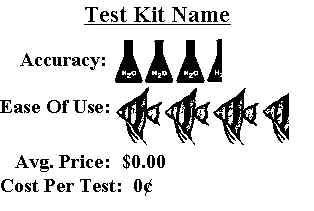|

| |
Two sets of five identical vials were each filled with one of the types of test
solutions (nitrite or nitrate) and were labeled. The labels were obscured and
the vials were mixed to a random order (within each corresponding set). A type
of test kit was chosen and a vial was selected randomly for testing from the
corresponding set of vials, until all vials had been selected. The tests were
performed exactly following the respective manufacturers’ instructions
included in the packaging. The results of the tests were recorded. The label was
then removed from the vial and the identity was noted. This procedure was
repeated for each test kit.
Interpreting The Results
  A
test kit’s accuracy was judged based on how close the observed reading was to
that of the concentration of the test solutions (ppm NO21-
or ppm NO31-). The accuracy was then fit to a scale of 1
to 5 flasks, with 5 being the most accurate. A kit’s ease of use was judged
based on many factors. A few of the factors were: 1) ease of filling the test
vial, 2) ease of comparing the sample reading to the provided gradient
concentration chart, 4) ease of spilling the test vial, 5) ease of following the
manufacturer’s directions, etc. Some factors were more important than others,
but all of them were taken into account in evaluating the kit’s ease of use.
The evaluation was then fit to a scale of 1 to 5 fish, with 5 being the most
easy to use. After all of the evaluations were completed, the kit with the best
overall performance and price was given the chemist’s choice award. The
results were compiled into an "at-a-glance" table for easy direct
comparison of specific brands and how they stacked up against each
other................. A
test kit’s accuracy was judged based on how close the observed reading was to
that of the concentration of the test solutions (ppm NO21-
or ppm NO31-). The accuracy was then fit to a scale of 1
to 5 flasks, with 5 being the most accurate. A kit’s ease of use was judged
based on many factors. A few of the factors were: 1) ease of filling the test
vial, 2) ease of comparing the sample reading to the provided gradient
concentration chart, 4) ease of spilling the test vial, 5) ease of following the
manufacturer’s directions, etc. Some factors were more important than others,
but all of them were taken into account in evaluating the kit’s ease of use.
The evaluation was then fit to a scale of 1 to 5 fish, with 5 being the most
easy to use. After all of the evaluations were completed, the kit with the best
overall performance and price was given the chemist’s choice award. The
results were compiled into an "at-a-glance" table for easy direct
comparison of specific brands and how they stacked up against each
other.................
Previous Page
Order The Complete Article |

